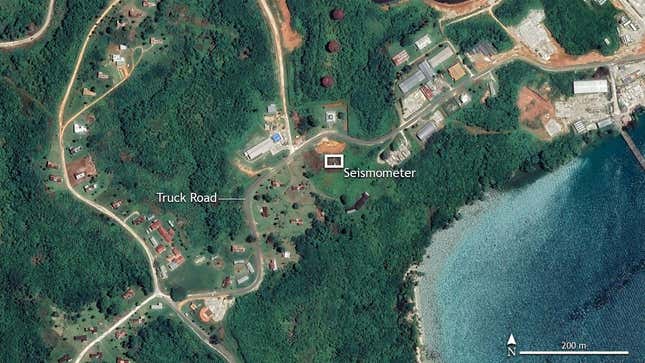In January 2014, a meteor entered Earth’s atmosphere in the Western Pacific, as evidenced by apparent vibrational signatures of the event in a seismic station in Papua New Guinea. Last year, scientists declared rubble recovered from the ocean floor as the rejectamenta of that event (and some even speculated it was a form of alien technology). But now, another team offers a different interpretation: the vibrations were caused by a truck on a nearby road, driving by at the same time the meteor plummeted through the atmosphere. What’s more, the rocky bits found on the Pacific floor were not from this meteor, the team concluded, which likely entered the ocean about 100 miles from the original search area.
“The signal changed directions over time, exactly matching a road that runs past the seismometer,” said Benjamin Fernando, a planetary seismologist at Johns Hopkins who led the research. The study will be presented next week at the annual Lunar and Planetary Science Conference in Houston.
“It’s really difficult to take a signal and confirm it is not from something,” Fernando added. “But what we can do is show that there are lots of signals like this, and show they have all the characteristics we’d expect from a truck and none of the characteristics we’d expect from a meteor.”

Meteors are chunks of space debris enter Earth’s atmosphere. They come in many shapes and sizes and can clue scientists into the history of the solar system and the origins of water on Earth. The largest of this century was the Chelyabinsk meteorite that exploded over Russia in 2013, shattering windows, setting off car alarms, and injuring about 1,600 people. Not all meteors are totally foreign, though; last year, a group of researchers studied a meteorite that landed in the Sahara Desert in 2018 concluded it actually originated from Earth.
Initial analysis of the meteor fall was conducted with data from the nearby seismometer AU MANU on Papua New Guinea’s Manus Island. That analysis, published in September 2023, concluded the meteorite was of interstellar origins and fell into the ocean just north of the island.
But in the new paper, Fernando’s team relied on data from sound stations in Australia and Palau, originally built to detect the tremors of nuclear tests. That data indicated that the meteor likely fell over 100 miles from where initial searches for the space rock were conducted.
“Localisation of the strewn field is reliant on a single station and a signal with no clear phases,” the researchers wrote. “Therefore, we consider it to be at best highly overstated and at worst entirely erroneous.”
Avi Loeb, a prominent Harvard researcher and proponent of the idea that the interstellar object ‘Oumuamua may have been an alien probe, speculated that the recovered bits of spherical rock could be alien technology. But that the material is not related to the 2014 fireball, based on the recent team’s numbers.
“Whatever was found on the seafloor is totally unrelated to this meteor, regardless of whether it was a natural space rock or a piece of alien spacecraft—even though we strongly suspect that it wasn’t aliens,” Fernando said.
A team led by Loeb will also be presenting their findings, which characterize the composition and potential origin of the 850 spherules, in next week’s conference.
Fernando’s team concluded that the spherules are indeed meteorites, or a combination of meteorite and terrestrial material, but not related to the 2014 meteor fall.
The truth is out there—whether at the bottom of the sea or in the data collected as the meteor fell. And even if the findings aren’t as out-of-this-world as alien technology, discussing all possibilities and reviewing the data through the scientific process could tie a neat little bow on this meteoritic saga.
More: 10 Years Ago Today, the Chelyabinsk Meteor Exploded Over Russia

